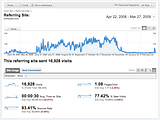Blogs will likely have a higher bounce rate than other, more traditional sites. A blog features multiple forms of content on the main page, including up to ten or so recent posts, which is the main area that readers look at when visiting your blog. Secondly, many people have placed an "about" statement or area in their sidebar, again reducing the number of people who click through to other pages.
When a user clicks through your blog, they have "reduced" the bounce rate of your site, as they are reducing the number of people who have left your site after entering it. The main areas that a user would view are: additional pages of your blog, other posts (archives), or a link to view the comments. The more frequently you can get them to do this, the higher the pages/visit count rises. I'll be covering several ways of reducing bounce rate in this sense in an upcoming post.
Let's now look at the true definition of bounce rate, as per Wikipedia.
- Clicking on a link to a page on a different website, closing an open window or tab, typing in a new URL, clicking the "Back" button to leave the site, and a session timeout (staying on the page for greater than 30 minutes) are all considered "bounces."
- Bounce rate is equal to the number of single page accesses and entries.
- An analytics specialist says that it is "really hard to get a bounce rate under 20%, anything over 35% is cause for concern, 50% (above) is worrying."
Now that we have the definition of a bounce rate, let's look at the traffic from Entrecard compared to other referring sites and search engines. I've attached an image, which shows the main detailed overview of the traffic with this blog.

Please Note: This blog may not fill the "average" of all blogs in the network or throughout the web - we cater to Entrecard users or people who may want to become members. Therefore, there is less traffic from multiple referring sites, and more from Entrecard. The main promotion method of this blog is through Entrecard and I have only spent time "dropping" on other sites to accumulate the traffic.
I will consider a variation of greater than 5% a "difference" between Entrecard traffic and "normal" traffic.
The largest single referrer for my blog is the Entrecard Category Browser, which is surprising, as most would think of the Inbox as the main area for traveling to other sites. Following this first referral path, detailed pages for my blog, and Inboxes for specific members are listed (with 2,137 paths to the Entrecard.com site, the total number of inbox visits is likely greater than that of the Browser). In some ways, you can track all the way down to the particular members, and how often they visit your blog.
Some Statistics for Comparison
– Between April 22, 2008 and March 27, 2009, Entrecard sent 16,928 visits to the site.

Please Note: This blog may not fill the "average" of all blogs in the network or throughout the web - we cater to Entrecard users or people who may want to become members. Therefore, there is less traffic from multiple referring sites, and more from Entrecard. The main promotion method of this blog is through Entrecard and I have only spent time "dropping" on other sites to accumulate the traffic.
I will consider a variation of greater than 5% a "difference" between Entrecard traffic and "normal" traffic.
The largest single referrer for my blog is the Entrecard Category Browser, which is surprising, as most would think of the Inbox as the main area for traveling to other sites. Following this first referral path, detailed pages for my blog, and Inboxes for specific members are listed (with 2,137 paths to the Entrecard.com site, the total number of inbox visits is likely greater than that of the Browser). In some ways, you can track all the way down to the particular members, and how often they visit your blog.
Some Statistics for Comparison
– Between April 22, 2008 and March 27, 2009, Entrecard sent 16,928 visits to the site.
– This accounts for 59.43% of the total site traffic.
– Pages per visit with Entrecard is 1.08, 2.26% less than the site average of 1.11.
– Average time on site is 30.97% less than the entire site average, at 00:00:30 versus 00:00:43.
– % New Visits (a greater percentage shows loyalty) is 77.42%, 3.09% lower than the site average of 79.89%.
– Bounce rate through Entrecard is 93.41%, 0.49% higher than the site average at 92.96%.
– 85 of 119 traffic sources reported a bounce rate of 100%.
What This All Means
Looking at the bounce rates between all traffic and that of Entrecard, there is little to no difference. Unlike what most people think, Entrecard traffic is not vastly different from that of all other sources, and can even be better than traffic form independent blogs or search engines.
All things considered, the only significant difference between the various usage elements was time on site, which shouldn't come as a surprise. This means that between dropping, the average person spends thirty seconds on your site, reading content, waiting for the page to load, or going elsewhere.
Conclusion
Entrecard helps connect blog owners and their blogs together, so it is obvious that unless you have a blog that appeals to other people, you will not be able to reduce your bounce rate or increase the subscriber level of your blog.
Compare your blog's traffic from Entrecard to that of other sources - what do you see?
1 comment:
Nice theme. Does Entrecard provide you with a lot of high quality visitors?
Post a Comment